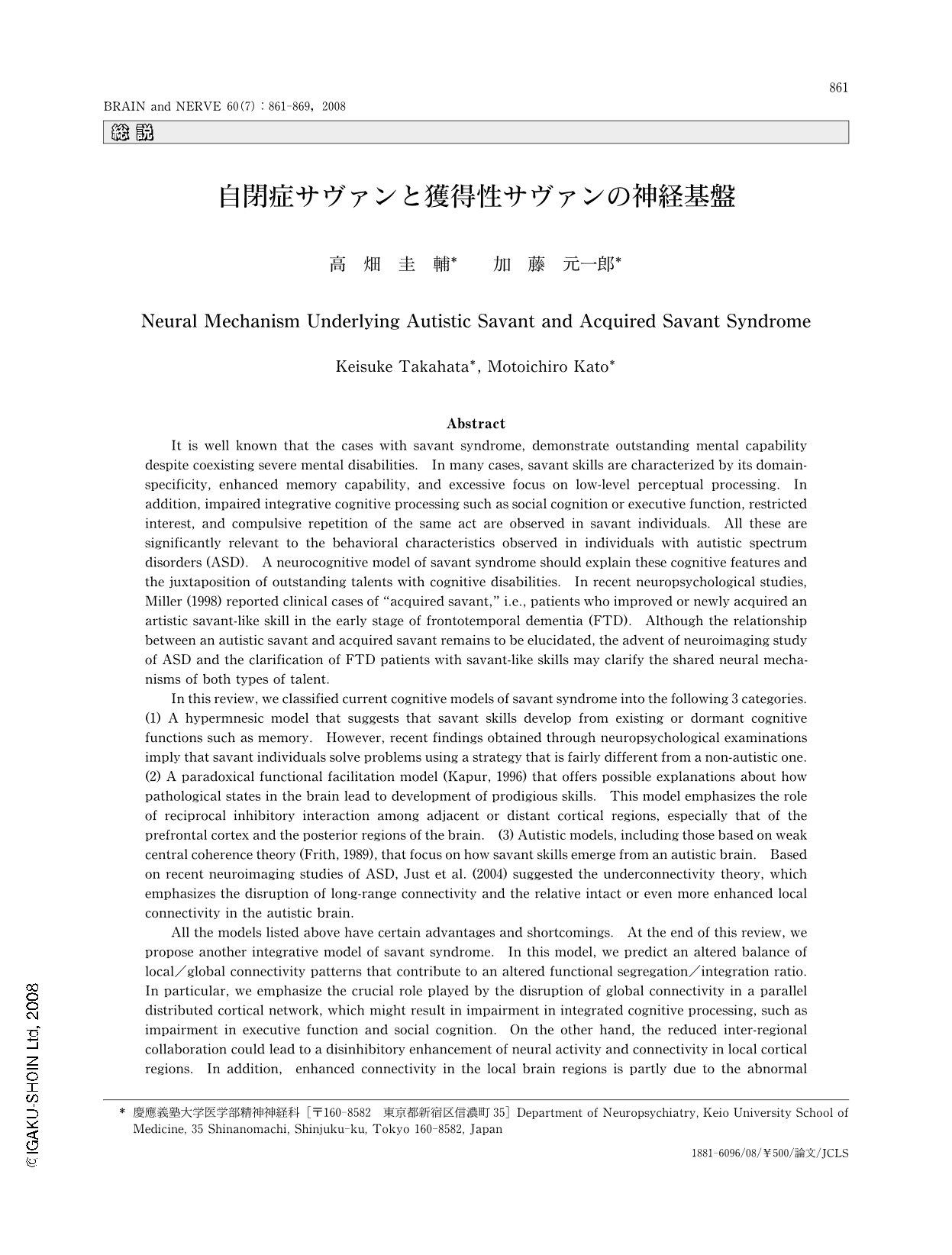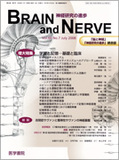Japanese
English
- 有料閲覧
- Abstract 文献概要
- 1ページ目 Look Inside
- 参考文献 Reference
はじめに
深刻な精神神経障害によるハンディキャップを持ちながらも,一方で突出した「才能の小島(island of talent)」を持つ患者を,「サヴァン症候群(savant syndrome)」1,2)と呼ぶ。サヴァン症候群はごく稀にしかみられないものの,その存在は古くから知られていた。1887年にDownが記述した,先天的な知能低下にもかかわらず類い稀な才能を併せ持った複数の症例は,サヴァン症候群に関する最初期の報告である。その際Downは,その逆説的な才能を強調して,idiot-savant(白痴の天才)と名付けた3)。彼らの才能は,音楽,絵画,彫刻,計算,記憶など多岐に及び,しかもすべての症例に重度の精神遅滞や認知障害が併存していた。また,映画「レインマン」に登場するレイモンド・バビットのモデルとなったキム・ピークは,脳梁欠損などの深刻な中枢神経系の異常が存在するにもかかわらず,過去に読んだ約9,000冊の書物の内容を正確に記憶しているという驚異的な能力を具えたサヴァンとして知られている4)。これまでに,サヴァン症候群の症例は数多く報告されているが,彼らの認知過程や神経基盤の解明に向けた研究が行われるようになったのは比較的最近のことである。サヴァン症候群に出現する驚異的な才能は,従来の高次脳機能における障害や欠陥という概念だけでは説明することができないものであり,彼らの認知過程と神経基盤の詳細を明らかにすることは,われわれの脳内の情報処理過程を解明するためにも大きな役割を占めるものと思われる4,5)。
Abstract
It is well known that the cases with savant syndrome, demonstrate outstanding mental capability despite coexisting severe mental disabilities. In many cases, savant skills are characterized by its domain-specificity, enhanced memory capability, and excessive focus on low-level perceptual processing. In addition, impaired integrative cognitive processing such as social cognition or executive function, restricted interest, and compulsive repetition of the same act are observed in savant individuals. All these are significantly relevant to the behavioral characteristics observed in individuals with autistic spectrum disorders (ASD). A neurocognitive model of savant syndrome should explain these cognitive features and the juxtaposition of outstanding talents with cognitive disabilities. In recent neuropsychological studies, Miller (1998) reported clinical cases of "acquired savant," i.e., patients who improved or newly acquired an artistic savant-like skill in the early stage of frontotemporal dementia (FTD). Although the relationship between an autistic savant and acquired savant remains to be elucidated, the advent of neuroimaging study of ASD and the clarification of FTD patients with savant-like skills may clarify the shared neural mechanisms of both types of talent.
In this review, we classified current cognitive models of savant syndrome into the following 3 categories. (1) A hypermnesic model that suggests that savant skills develop from existing or dormant cognitive functions such as memory. However, recent findings obtained through neuropsychological examinations imply that savant individuals solve problems using a strategy that is fairly different from a non-autistic one. (2) A paradoxical functional facilitation model (Kapur, 1996) that offers possible explanations about how pathological states in the brain lead to development of prodigious skills. This model emphasizes the role of reciprocal inhibitory interaction among adjacent or distant cortical regions, especially that of the prefrontal cortex and the posterior regions of the brain. (3) Autistic models, including those based on weak central coherence theory (Frith, 1989), that focus on how savant skills emerge from an autistic brain. Based on recent neuroimaging studies of ASD, Just et al. (2004) suggested the underconnectivity theory, which emphasizes the disruption of long-range connectivity and the relative intact or even more enhanced local connectivity in the autistic brain.
All the models listed above have certain advantages and shortcomings. At the end of this review, we propose another integrative model of savant syndrome. In this model, we predict an altered balance of local/global connectivity patterns that contribute to an altered functional segregation/integration ratio. In particular, we emphasize the crucial role played by the disruption of global connectivity in a parallel distributed cortical network, which might result in impairment in integrated cognitive processing, such as impairment in executive function and social cognition. On the other hand, the reduced inter-regional collaboration could lead to a disinhibitory enhancement of neural activity and connectivity in local cortical regions. In addition, enhanced connectivity in the local brain regions is partly due to the abnormal organization of the cortical network as a result of developmental and pathological states. This enhanced local connectivity results in the specialization and facilitation of low-level cognitive processing. The disruption of connectivity between the prefrontal cortex and other regions is considered to be a particularly important factor because the prefrontal region shows the most influential inhibitory control on other cortical areas. We propose that these neural mechanisms as the underlying causes for the emergence of savant ability in ASD and FTD patients.

Copyright © 2008, Igaku-Shoin Ltd. All rights reserved.


